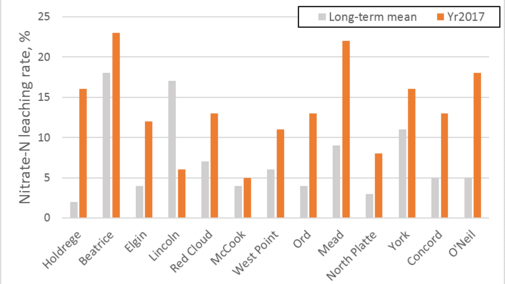Nitrate, the major form of inorganic nitrogen (N) in soils of crop fields, is subject to leaching loss when excess water drains beyond the crop’s active rooting depth (i.e., 3 feet). Much of Nebraska has had above average rainfall this spring (Figure 1). The average rainfall of the 13 locations illustrated from March 1 to May 21 is 6.1 inches, which is 1.6 inches more than the long-term mean. Beatrice and Holdrege had 4 inches or more total rainfall than the long-term mean of this period. Given these numbers, many producers and crop advisors may be wondering about nitrate-N leaching losses and whether they will need to add more N fertilizer later in the season.
Using real-time weather data as of May 21, 2017, simulation by the Maize-N model (http://hybridmaize.unl.edu/Maize-N) suggests some soils have likely experienced very wet conditions with periods when soil water exceeded field capacity. As soils do not retain water above field capacity when internal drainage is possible, excess water will percolate downward, carrying nitrate-N below the crop rooting depth.
For silt clay loam soils, our estimate suggests nitrate leaching, on average across the 13 locations, to be 14% of the total soil nitrate-N present in mid-April (Figure 2), whereas the long-term average value is around 7%. Potential loss from nitrate leaching is relatively higher for eastern Nebraska, including Beatrice (23%), Mead (22%), and O’Neill (18%). For lighter soil textures the potential loss from nitrate leaching is even greater while the opposite is true for heavier textures. For example, the average nitrate leaching for a sandy loam soil was estimated to be 20% of total soil nitrate present in mid-April for the 13 locations.
Because the soil profile in most fields has likely been fully recharged with this year’s precipitation, further rainfall in the coming weeks will likely lead to more nitrate leaching. For fields where pre-plant nitrogen fertilizers were applied, producers should consider adding nitrogen when sidedressing during the growing season to compensate for the nitrogen losses that may have occurred.


Nitrogen needs to be in the nitrate form to leach. The amount of fertilizer N in nitrate form by mid-April will depend on time of application, fertilizer type, and whether an inhibitor or a slow release N source was used. Most fertilizer N applied in the spring would not have been in nitrate form by mid-April. Although denitrification is another possibility when soils are saturated for more than three days, the amount of denitrification would be small in most circumstances since the temperatures have been mostly cool.
The Next Step
The Nebraska Corn Board is funding the authors to develop a web tool to allow individuals to make these calculations for their farms. It is expected to be available in a year.

